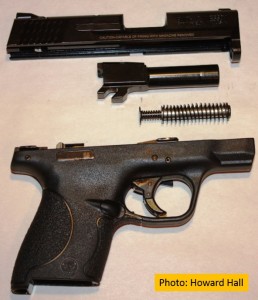
A Little History
Following the immense popularity of Glock’s entry into the U.S. law enforcement and civilian firearms marketplace, Smith & Wesson introduced the polymer-framed Sigma in 1993. However, S&W’s design was so close to a Glock that a copyright infringement suit ended the Sigma’s run in 1997. Ten years later, S&W re-entered the polymer-framed striker-fired pistol market with the M&P (Military and Police) line. The 4.5 inch barreled .45 caliber M&P won Handgun of the Year in 2007 and it’s popularity spawned mid-sized and compact versions of the venerable .45ACP as well as 9mm chamberings in 2008. Later, in 2011, Smith & Wesson produced the M&P 22, chambered in .22 caliber long-rifle.
Also similar to Glock, the standard M&P line of handguns had wide-body frames which could contain “double stacked” magazines… and were somewhat difficult to conceal. So, in 2012, Smith & Wesson introduced the M&P Shield in 9mm and .40cal with a thinner slide and frame, and thus “single stack” magazine to enhance concealability. In 2014, Smith & Wesson introduced the M&P Bodyguard chambered in the diminutive .380ACP.
Initially, the M&P design incorporated only two “passive” safeties (a striker block to prevent inertial movement from striking the primer and a “hinged” trigger design which prevented trigger movement unless it was firmly pressed by the shooter). However, many shooters who wanted to use the M&P pistols for concealed carry or a back-up gun desired the addition of an “active” safety (which requires the conscious activation and de-activation on behalf of the handler). Thus Smith & Wesson incorporated an active “thumb safety” as a factory option in their M&P line.
In addition to client requests for training with a sub-compact M&P Shield, I too wanted to learn more about this handgun and considered it for my personal concealed carry. So I took advantage of a Father’s Day sale this past June and purchased a Smith & Wesson M&P Shield 9mm for training and personal protection.
Introducing the Smith and Wesson M&P Shield 9mm


Impressions, Fit, Function, and Finances
Eager to evaluate this pistol and test its “out of the box” reliability, I took the Smith & Wesson M&P Shield 9mm directly from the store counter to the range and put it to the test by firing 300 rounds of 115 grain Full Metal Jacket ammunition from various distances. I’m fairly impressed with the ease of operation and comfort in this small and affordable package. In the following paragraphs, I’ll evaluate its fit, function, and finances along with a full range report. Continue Reading »
Article by – Howard Hall

No comments:
Post a Comment